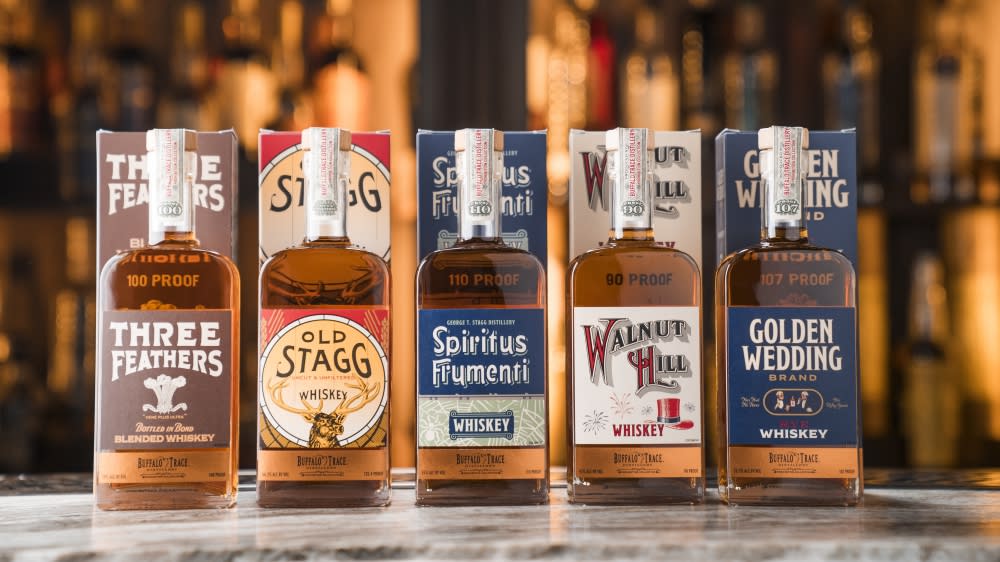Buffalo Trace Launches New Prohibition-Inspired Whiskey Collection

Buffalo Trace is known for producing some highly collectible whiskeys like Pappy Van Winkle and the Antique Collection. So the odds are pretty good that the new Prohibition Collection will join the ranks of these unicorn bottles as well, and we have the details that will explain why that could be.
The Prohibition Collection is a new annual whiskey series that pays tribute to whiskeys that were legally distilled and distributed by Buffalo Trace’s precursor, the George T. Stagg Distillery, during the Noble Experiment. From 1920 until Prohibition’s repeal in 1933, you were still allowed to purchase alcohol with a doctor’s prescription due to the belief that alcohol had some health benefits. That is actually a theory that is still under discussion—as soon as one study promoting some health benefits of alcohol comes out, another one arises to refute it. The bottom line, however, is that it’s dangerous and misleading to promote alcohol as being medicinal, let alone healthy, but this new collection recognizes that history without actually making any such claims.
More from Robb Report
Taste Test: Metallica's Blackened Whiskey Releases Its Best Expression Yet
This Underdog Whiskey Just Won Best in Show at the NY Wine and Spirits Competition
Two Maker's Mark Alums Are Opening Their Own Bourbon Distillery
Even while the production and sale of alcohol was banned during Prohibition, the U.S. government granted six distilleries licenses to store and distribute booze for medicinal purposes, and George T. Stagg in Frankfort, Kentucky was one of these. The five whiskey brands that have been resurrected by Buffalo Trace to appear in this new collection are as follows, each one more of an homage to the original than an exact replica.
Old Stagg is an uncut, unfiltered, barrel-proof bourbon bottled at a high 132.4 proof, much like its more modern siblings George T. Stagg and Stagg. Tasting notes describe an oaky, vanilla aroma, and a sweet palate with notes of leather and dark cherries.
Golden Wedding is a rye whiskey bottled at 107 proof which is based on a Pennsylvania brand originally made at the Joseph S. Finch Distillery by Schenley Distilling (which bought George T. Stagg in 1929). It became a Canadian whisky in the 1940s before production ceased. Tasting notes describe a grainy, herbal palate with pickle and spice.
Three Feathers is a bottled-in-bond bourbon (100 proof, at least four years old) created by master blender Drew Mayville. According to Buffalo Trace, this brand dates back to the early 19th century and at various times was a rye whiskey, bottled-in-bond whiskey, and a blended whiskey. This new iteration has light tropical fruit notes on the palate with some smoke and caramel, and a cocoa finish.
Walnut Hill was bottled at George T. Stagg during Prohibition, but little else is revealed about the origin of this whiskey. Today it’s a 90 proof high-rye bourbon with notes of corn, oak, sweet molasses, stone fruit, and vanilla.
George T. Stagg Distillery Spiritus Frumenti is a tribute to the “medicinal whiskey” produced at the distillery during Prohibition–the Latin translates to “spirit of the grain.” This is a 110 proof wheated bourbon with notes of cherry and oak, and a finish with vanilla, wheat, and citrus.
“Each of these brands disappeared slowly in the years after Prohibition, but they were integral to our survival,” said Buffalo Trace master distiller Harlen Wheatley in a statement. “Without them, today there would be no Buffalo Trace, Eagle Rare, or Weller bourbons. The Prohibition Collection is a tribute to these great whiskeys from our past.”
“When we discovered these brands, and others, in our distillery’s history, we could not wait to bring them back to life and tell their stories again,” added global brand director Andrew Duncan. “By aging and selling barrels from numerous distilleries all over the country, the Buffalo Trace Distillery site played a key role in keeping American whiskey alive during one of the most unique periods in the history of the spirits industry.”
Let’s cut right to the chase here: This collection is going to be extremely difficult to get your hands on. It will be sold as a five-bottle set of smaller 375-ml bottles in a wooden display case priced at $1,000. So, yes, you’ll see it on the secondary market for much more than that when it is released in October. Good luck to the dedicated unicorn hunters, and let’s be thankful that modern medicine has come a long way from the days when your doctor would prescribe a shot of bourbon for your cold.
Best of Robb Report
Why a Heritage Turkey Is the Best Thanksgiving Bird—and How to Get One
The 10 Best Wines to Pair With Steak, From Cabernet to Malbec
Sign up for Robb Report's Newsletter. For the latest news, follow us on Facebook, Twitter, and Instagram.


